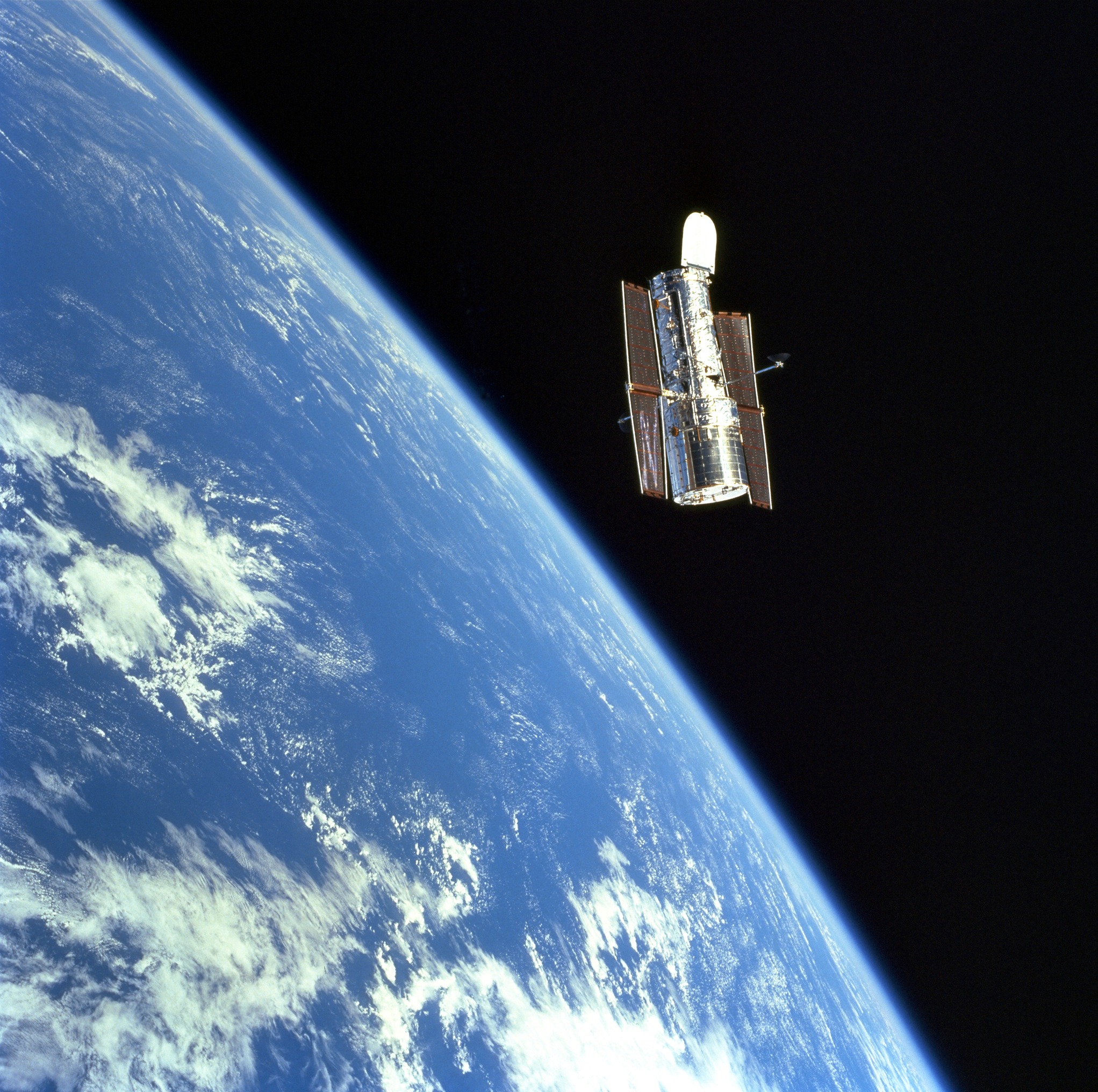
Twenty-five years ago, yesterday, on 24 April 1990, one of the most important missions in the annals of scientific discovery got underway, with the launch of NASA’s Hubble Space Telescope. As described in yesterday’s AmericaSpace history article, this $1.5 billion observatory—with its five instruments and finely ground mirrors—promised to revolutionize astronomy. It would peer deeper into the cosmos than ever before, unhindered by the distorting effects of Earth’s atmosphere. In time, it would examine “nurseries” of young stars and “graveyards” of ancient ones, would study galaxies in unprecedented depth, would watch as a comet smashed into Jupiter, would trace violent storms on Uranus and Neptune, and would create maps of far-off Pluto. And 25 years ago, today, on 25 April 1990, the telescope was released from the payload bay of Shuttle Discovery by the crew of STS-31. However, its childhood was marred by technical difficulty, which made it the butt of cruel humor and an object of criticism from NASA’s opponents.
None of this could have been further from anyone’s mind on 10 April 1990, as controllers counted down toward the launch of the telescope on STS-31. Aboard Shuttle Discovery were five astronauts—Commander Loren Shriver, Bruce McCandless, Steve Hawley, Kathy Sullivan, and the man who would one day become NASA’s first African-American Administrator, Charlie Bolden—who were tasked with the enormous responsibility of getting this gigantic icon of astronomy into the highest orbit ever attained by the shuttle, some 380 miles (610 km) above Earth. However, the 10th was not to be their day. The countdown clock stopped at T-4 minutes, when abnormal pressures and turbine speeds were detected in one of Discovery’s Auxiliary Power Units. Two weeks later, on the 24th, they were back for another try. This time, the clock halted at T-31 seconds, just before the on-board computers assumed primary control, due to glitch with a liquid oxygen fill and drain valve. When this had been rectified, STS-31 roared into space. “Our window on the Universe!” came the call from the launch commentator, as Discovery speared toward orbit, atop a pillar of golden flame.
Within hours, the shuttle’s payload bay doors were open, revealing the monster telescope in all its splendour. More than 43 feet (13 meters) long, glistening with shiny insulation and weighing an impressive 24,250 pounds (11,000 kg), Hubble filled the bay and left the astronauts awestruck. In fact, its aluminum coating was so reflective that it blazed brightly in the harsh, unfiltered sunlight … so brightly that Steve Hawley would later recommend that future servicing missions should rendezvous with the telescope during orbital darkness to avoid momentarily blinding the astronauts or their cameras.
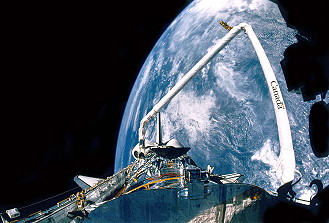
Deployment was slated to occur on the second day of the mission, 25 April 1990, and the STS-31 crew received special wake-up music in the form of the song “Space Is Our World,” written by a Houston-based band, Private Numbers.
Later that morning, Hawley gingerly grappled the massive payload and positioned it above the bay, with its large aperture door facing forward. Its two high-gain antennas were released, springing “downward” and “outward,” and the next step was to open British Aerospace’s solar arrays, which would unfurl like kitchen roller blinds. The first array came out perfectly, and Shriver reflected that it was incredible to behold. The second array was more problematic. It began to unroll for a few centimetres, then abruptly stopped. Everyone’s heart skipped a beat. Time was of the essence. After cutting umbilical power to the telescope, the astronauts had just two hours on internal batteries to get the arrays open and enable Hubble to draw its own electricity. If that did not happen, the batteries would die … and so would the telescope. The worry went up in notches with the realization that Hubble might be in severe difficulty.
An EVA repair seemed the only solution. Having reduced Discovery’s cabin pressure the previous night, McCandless and Sullivan were already downstairs, clad in their space suits, in the airlock, with tools, ready to go outside. McCandless was convinced that he knew the source of the problem: a glitch with a tension monitoring module. This was a unit of software to detect any excessive strain on the array and prevent it from tearing or binding. It would stop the array-deployment process and the spacewalkers would then have to fix it manually. To give them more time, they had partially completed their pre-EVA procedures before Hubble was grappled. “What’s left,” Sullivan told the NASA oral historian, “is to button up the suit, breathe 40 minutes of pure oxygen, close the hatch, depress and get outside.”
It was a double-edged sword, for despite having a spacewalk it also meant that Sullivan’s other task of photographing the deployment would be missed. Before launch, she had resolved to literally “wallpaper the telescope with photos” … in fact, she wanted a cover shot on Aviation Week. Now, after working for five years on Hubble, she was locked up in the airlock and might not even see the instant of its release. With only minutes remaining before she and McCandless would have been directed to fully depressurize the airlock, Mission Control told them that the problem was an erroneous software indication … from the tension monitoring module. An engineer requested permission to command the module to “No-Op” (“No Operation”, effectively taking it “out of the loop”) and was certain that this would enable the stubborn second array to unfurl. STS-31 Flight Director Bill Reeves concurred and Capcom Story Musgrave radioed up the news: Hawley was to orient Hubble in a ready-to-deploy attitude and if the attempt to “No-Op” worked, the array would likely start unfurling immediately and they would have to release the telescope as quickly as possible.
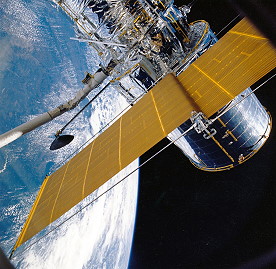
It worked.
Charlie Bolden was astounded, but McCandless offered a wizened grin. He had worked on Hubble for so long that he knew, instinctively, what had caused the problem.
Steve Hawley’s primary concern during the deployment, aside from the array, was the very remote chance that Discovery’s Canadian-built Remote Manipulator System (RMS) mechanical arm might fail. The joints of the arm were intentionally limited in terms of their speed, thereby offering him some margin to respond to contingencies, and that meant that the motion he could command was restricted. As he lifted Hubble, it “wobbled”—a lot more than the simulator had taught him that it should—and not until after landing did he realize that the signal “noise” in the joints contributed to random imparted motions. In his post-mission debriefings, he recommended that future simulations should take joint noise into account … a recommendation which would prove hugely beneficial for Swiss astronaut Claude Nicollier, who would grapple Hubble on the first servicing mission in December 1993 and for Hawley himself, who would fly the second in February 1997.
Charlie Bolden was not immune to the irony that the crew had actually practiced a solar array deployment failure during their last integrated simulation, shortly before launch. In that instance, McCandless and Sullivan had manually wound out the array, although they knew that doing such an action for real had the potential to severely damage the telescope. “Once you did that,” Bolden said, “it took it out of its automatic mode and it would no longer be able to take care of itself … sort of like taking a baby from the womb, putting it on a respirator and putting it in a position where the rest of its life it would need something. That was what that would have meant for Hubble … until you send another crew up and put on another set of solar arrays and reset the clock.”
Disappointment at being unable to perform an EVA extended a little further when McCandless and Sullivan were unable to see the moment of deployment. Bolden certainly felt for them, still cooped up in the airlock. “So we deploy Hubble, coming off the Pacific Ocean, across the west coast of South America,” he told the NASA oral historian, “and it’s just the most beautiful thing you can imagine. It comes off the end of the arm and down. We’re looking at the Andes Mountains and it goes right across the coast between Bolivia and Venezuela.” Shortly afterward, he and Shriver pulsed Discovery’s thrusters, twice, to raise their orbit slightly, causing them to fall steadily “behind” the telescope. As Hubble drifted serenely away, the three men on the flight deck gaped at what they were seeing. Then, all of a sudden, and in unison, they all barked: “Camera! Somebody get a camera!”
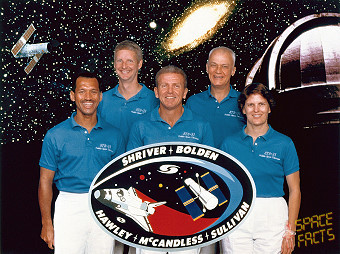
Bolden helped to save the day in terms of the photography. An IMAX large-format camera was already filming the deployment from the rear of the payload bay, and Bolden also acquired some spectacular footage from the cabin, with the hand-held IMAX. Having sealed McCandless and Sullivan in the airlock, he shot a length of film as he floated upstairs to the flight deck, focusing firstly on Shriver at the orbiter’s controls, then on Hawley at the RMS controls, and then through the windows to reveal the Hubble Space Telescope in all its magnificence. It was not like a “normal” camera, where it was possible to see what was occurring through the lens; rather, Bolden had nothing to gauge whether he was doing the right thing. After the flight, his biggest surprise was not just that the camera worked, but that it also stayed in focus. Later, IMAX would include Bolden’s imagery as part of its Blue Planet and Destiny in Space documentaries.
Four days later, on 29 April 1990, Shriver and Bolden brought Discovery smoothly onto the concrete runway at Edwards Air Force Base in California’s Mojave Desert, capping a mission which promised to open a new set of eyes on the Universe. In the first few weeks, Hubble’s early problems seemed benign: a few communications glitches, drifting star trackers, and snagged coaxial cables were part and parcel in the process of wringing out a new spacecraft. More serious concerns arose when temperature changes bent materials in the solar arrays’ booms, the effect of which was magnified by the orientation mechanism in such a way that it physically “bounced” the whole telescope. The result was a “jittering” in Hubble’s images and, since the booms only stabilized in the final few minutes of orbital daylight, the pointing system was only able to meet its design specifications for a fraction of each orbit. NASA engineers worked with their counterparts at Lockheed to change the control program in Hubble’s computer and successfully counteracted the vibrations. On 21 May 1990, the telescope returned its first images of a double star in the Carina system, and these were lauded as being much clearer than were achievable with ground-based instruments.
Four weeks later, calamity befell the mission. On 24 June Hubble failed a focusing test. Its secondary mirror had been adjusted to focus the incoming light from a celestial source, but a fuzzy ring—like a halo—encircled even its best images, creating a blur. Additional tests revealed that the telescope was suffering from a condition known as a “spherical aberration” in its primary mirror. In essence, Perkin-Elmer, had ground it to the wrong specification, removing too much glass and polishing it too flat … by a mere fiftieth of the width of a human hair. The consequence was that Hubble was unable to acquire sharp images. With mounting horror, NASA realized that its attempts to sell its scientific showpiece on the basis of its ability to see further into the cosmos than ever before, with unprecedented clarity, now became increasingly hollow. The promised white knight of astronomy was turning instead into a white elephant.
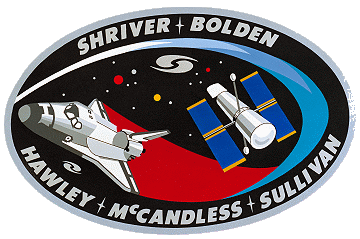
Even Hubble’s chief scientist, Ed Weiler, admitted that its capabilities were comparable only to “a very good ground telescope on a very good night.” The politicians were quick to vent their fury. Senator Barbara Mikulski from Maryland, exploded that Hubble was “a techno-turkey” and wasted taxpayers’ money. Meanwhile, Senator Al Gore of Tennessee—later vice president during the Clinton administration—observed that, for the second time in less than half a decade, NASA’s quality control shortcomings had been exposed. The press had a field day. Particular venom was leveled at the fact that NASA had accepted Perkin-Elmer’s $64.2 million bid to build the mirror and rejected a more expensive, though more thorough, $99.8 million proposal from Eastman Kodak and defence contractor Itek. On 28 July, the New York Times reported that Kodak-Itek’s bid would have subjected the mirror to two independent checks of its grinding and polishing accuracy. Almost certainly, this would have caught the error before launch.
NASA responded that, with 20-20 hindsight, it would have cost $100 million to incorporate additional tests and independent checks of the telescope optics into the Perkin-Elmer contract, but the effect upon the general public was the same. The space agency was rendered a laughing-stock on late-night TV talk shows. David Letterman compiled a pejorative list of “Top Ten Hubble Excuses,” whilst others criticized NASA for its mismanagement of both the Hubble development and the Solid Rocket Boosters (SRBs) which doomed Challenger. Several space policy analysts, including John Logsdon, noted that attitudes had changed from the 1960s, in which problems were anticipated and incorporated into planning, to the late 1970s and 1980s when little effort was made to prepare for unforeseen obstacles.
In early July 1990, NASA established an investigating committee, chaired by Lew Allen, the head of the Jet Propulsion Laboratory. His report—published the following November—harshly criticized the incorrect assembly of the “reflective null corrector,” an optical device used to determine the figure of Hubble’s mirror. The location of a lens in the device was improperly measured and the null corrector guided the polisher to shape a perfectly smooth mirror … with the wrong curvature. Analysis revealed that the curvature flaw in the primary mirror exactly matched the flaw in the null corrector. A second null corrector, made only with lenses, was also built to measure the vertex radius of the finished mirror. It, too, clearly identified an error in the primary mirror. However, neither warning sign was heeded and Allen’s report noted that “both indicators of error were discounted at the time as being themselves flawed.” During the fabrication process, technicians simply assumed the perfection of the mirror and of the reflective null corrector and rejected information from other independent tests, convincing themselves that no problems existed.
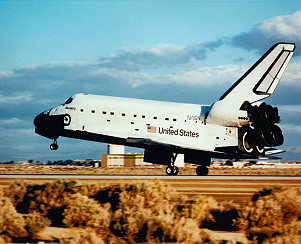
The errors went back to 1981-82, when Perkin-Elmer and NASA were both distracted by cost and schedule difficulties. Allen’s report particularly condemned Perkin-Elmer’s quality control and communications failures, as well as NASA’s own failure to correct them. In orbit, the spherical aberration was particularly obvious in its effect on Hubble’s wide-field planetary camera and faint object camera, both of which suffered in terms of their spatial resolution and their ability to acquire images of distant sources. Having said this, the aberration was well characterised and stable and, over time, enabled astronomers to optimize the results obtained by Hubble with sophisticated techniques, such as “deconvolution,” whereby software algorithms and image processing methods removed many of the blurring effects of optical distortion. Spectroscopy was less severely affected, because the instruments required less focused light and by increasing the exposure times it became possible to gather valuable images. However, the jittering of the solar arrays left Hubble’s high-speed photometer virtually useless. Nevertheless, by the end of 1991, the telescope had made almost 2,000 quality observations of hundreds of astronomical objects, including storms on Saturn and images of Pluto’s moon, Charon.
At the start of the following year, 1992, a quarter of all the papers presented before the American Astronomical Society drew on Hubble data. A repair mission, to be conducted no earlier than the fall of 1993, was critical in order to restore the telescope to its pre-flight billing and, although the primary mirror could not be replaced, a new device—the Corrective Optics Space Telescope Axial Replacement (COSTAR)—was built to restore its vision. COSTAR was manifested onto the first shuttle servicing mission to Hubble. Many senior administrators had little faith that the repair would work, but its success contributed greatly to a changing attitude toward the shuttle. As for Hubble itself, hardly anyone remembers the circumstances surrounding the spherical aberration today; far more detail abounds about its astounding scientific discoveries, its contributions to physics and astronomy and cosmology, and its importance to humanity as a species. The mirror problem is now little more than a footnote in history … and it should be, for Hubble has overcome the torment of its early childhood and performed grandly.
When the crew of the final shuttle servicing mission departed the telescope in May 2009, they left an observatory far more powerful and considerably more capable than even the magnificent showpiece which STS-31 had launched, almost two decades earlier. In the words of John Grunsfeld, who visited the telescope in space more times than any other human being, the honor and the privilege of being involved with such an icon made it worthy of the risk to his own life. Doubtless the other astronauts associated with Hubble feel the same way. “Hubble is worth risking my life,” he once said. “It’s that important. It’s teaching us so much about our world, the Universe, who we are and our place in the cosmos.”
And today, in 2015, after 25 wonderful and illuminating years, Hubble remains important and its teaching goes on.
This is part of a series of history articles, which will appear each weekend, barring any major news stories. Next week’s article will focus on the 30th anniversary of Mission 51B, a research flight which narrowly escaped catastrophe after leaving the launch pad.
Want to keep up-to-date with all things space? Be sure to “Like” AmericaSpace on Facebook and follow us on Twitter: @AmericaSpace




This was an interesting time in my life when I was dealing with my own “technical difficulties” as a technician working on a new type of aircraft being introduced into the arm of the military I was serving. The engines were junk and the same problem afflicted another type entering service at the time. Though the effect these powerplants had on my life is hard to quantify the ill will I bear to the officials that approved their acquisition is not- I will never trust the government to do the right thing. That said, I understand something the legions of deluded bizarro Ayn-Rand-in-Space Musk worshipers that contaminate the blogosphere do not; governmental resources and state-run public works projects are the only way humankind will expand into space.
The Space Shuttle and the Hubble telescope are the perfect example of both the downside and awesome possibilities that state-run projects represent. The NewSpace agenda in my view is not the solution- it is the worst thing that has ever happened to space exploration.
Even worse than the Space Shuttle stranding the U.S. in LEO for the last 40 years.
“Particular venom was leveled at the fact that NASA had accepted Perkin-Elmer’s $64.2 million bid to build the mirror and rejected a more expensive, though more thorough, $99.8 million proposal from Eastman Kodak and defence contractor Itek. On 28 July, the New York Times reported that Kodak-Itek’s bid would have subjected the mirror to two independent checks of its grinding and polishing accuracy. Almost certainly, this would have caught the error before launch.”
Excellent information to throw in the face of all those who scream cheap and grovel in the dirt before the lowest number of zeros. The Shuttle system itself is perhaps the supreme example of going cheap and ending up spending far more and getting very little in return. Of course the NewSpace crowd howls in protest at any hint of the Shuttle program being characterized as “cheap.” But in fact most of the design was based on cost saving measures.
The SpaceX hobby rocket is a similar set of compromises using obsolete technology riddled with shortcomings that limit performance compared to more technologically modern vehicles. The company has done a world class job of presenting these limitations as advantages but in truth it is a mediocre launch vehicle.
Greetings from Colorado! I’m bored to death at
work so I decided to check out your website on my iphone during lunch break.
I really like the knowledge you provide here and can’t
wait to take a look when I get home. I’m amazed at how fast your blog loaded on my cell phone
.. I’m not even using WIFI, just 3G .. Anyhow, fantastic site!